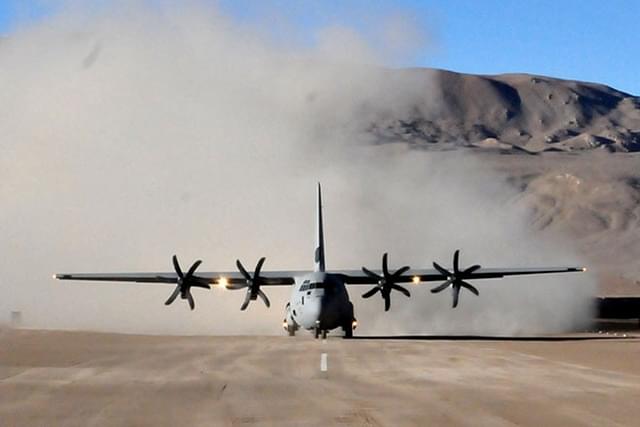Defence
Explained: How IAF's Night Landings Of C-130J In Border Areas Can Throw A Spanner In Chinese Plans

File Photo of C-130J Super Hercules transport aircraft landing in Ladakh. (X/ @ShivAroor)
The Indian Air Force (IAF) yesterday (24 May) achieved a milestone when it landed a US-made C-130J Hercules tactical airlifter at an advanced landing ground (ALG) in the eastern sector, presumably in Arunachal Pradesh, at night.
The landing was accomplished using night vision goggles that helped the pilots land the aircraft during limited visibility at night.
Earlier, in January this year, the IAF completed another night landing at a different airstrip in Ladakh, viz, the Kargil airstrip, which is situated at an altitude of 9,700 feet. Reportedly, this landing was the first night landing done by an IAF aircraft at an airstrip very close to the Line of Control (LoC).
These landings are part of the expansion of the IAF's operational capabilities in general and the C-130J airlifter in particular, demonstrating the ability to airlift manpower and supplies to remote areas that are otherwise connected with tenuous lines that are prone to closure, making the replenishment of forces deployed in the area, difficult.
These landings will not only provide crucial connectivity to the locals but also help in delivering humanitarian support in times of need.
Given that the Chinese in Tibet and Xinjiang operate 11 airfields that have grown in size and capacity to support fighter and airborne early warning (AEW) aircraft operations, it is imperative for India to strengthen infrastructure on its side of the border. This construction has, in fact, sped up radically after the clashes in the Galwan Valley in June 2020 and the ongoing four-year-long standoff.
Most of the Arunachal Pradesh road infrastructure is underdeveloped and still under construction.
Major highway projects, like the Frontier Highway, Trans-Arunachal Highway, and East-West Industrial Corridor Highway, are in various stages of construction and are only expected to be completed in the late 2027-2028 timeframe. This is made even worse by the weather and consequent landslides that make road connectivity tenuous and time-consuming.
Take, for example, the ALGs at Tuting and Mechuka. Both of these have no lateral connectivity.
If Indian Army wants to reinforce one ALG, say, from forces at Tuting to Mechuka (that is under pressure from the Chinese in a hypothetical war), one has to come back to Pasighat and then go to Mechuka.
With the completion of the Frontier Highway, this will get solved. However, until then, these night landings are extremely important.
They will help the army and air force induct forces and equipment rapidly, at night, even if the Chinese destroy some of the bridges in the area using long-range missile strikes. These covertly inducted forces can throw a spanner in Chinese plans.
Support Swarajya's 50 Ground Reports Project & Sponsor A Story
Every general election Swarajya does a 50 ground reports project.
Aimed only at serious readers and those who appreciate the nuances of political undercurrents, the project provides a sense of India's electoral landscape. As you know, these reports are produced after considerable investment of travel, time and effort on the ground.
This time too we've kicked off the project in style and have covered over 30 constituencies already. If you're someone who appreciates such work and have enjoyed our coverage please consider sponsoring a ground report for just Rs 2999 to Rs 19,999 - it goes a long way in helping us produce more quality reportage.
You can also back this project by becoming a subscriber for as little as Rs 999 - so do click on this links and choose a plan that suits you and back us.
Click below to contribute.
Latest